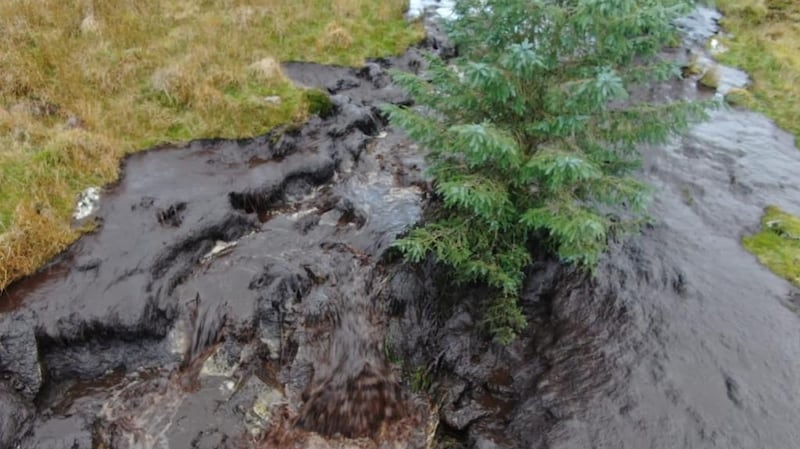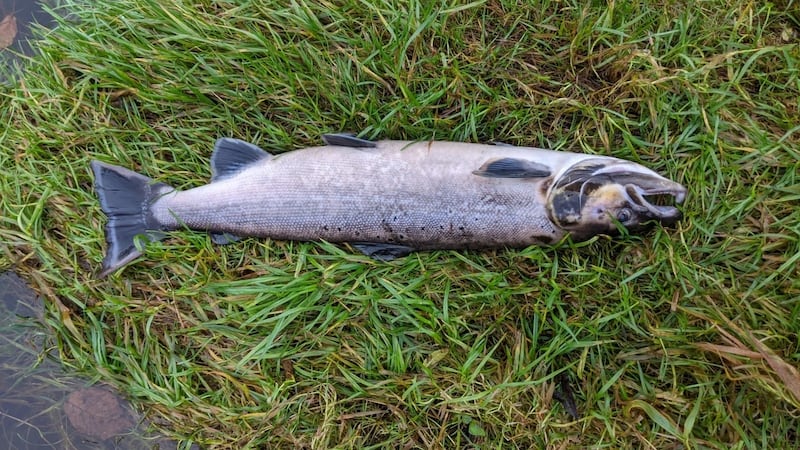The morning of November 14th last, Gary Irvine stood on a single-arched bridge that carries the road over the Shruhangarve stream in Meenbog, near Ballybofey in Donegal. Just 48 hours earlier, a major peat landslide had occurred at the construction site of a new 19-turbine wind farm upstream.
Peat was cascading into the river. A keen angler, there was only one question on Gary’s mind: are the Atlantic salmon, eels and trout still alive?
The Shruhangarve runs into the Mourne Beg river, an internationally important spawning ground for salmon. On that cold morning, Gary peered into the water in disbelief. “It was like thick chocolate flowing down,” he recalls.

“The water was black and when the light tried to penetrate it, it filled with tiny fibres.” He walked down towards the adjoining Derg River and put in a net. “I dreaded to think what it was like for fish swimming in that with the amount of polluting peat that was there.” Within 20 seconds, the mesh was clogged.
Footage of the Meenbog landslide appeared catastrophic; thousands of tonnes of thick, dark brown peat oozed down the mountain, meandering through the russet-coloured blanket bog like Willy Wonka’s chocolate river, and then poured into the waterways. The authorities are still investigating the collapse. But it marked the third landslide of 2020 and raises the question of why these peat failures are happening, and whether we should brace ourselves for more in the future.

‘Like a blister’
"In the crudest sense, they occur because of a detachment of a mass of peat from a bog, like a blister that ruptures," says hydrologist Dr Ray Flynn of Queen's University, Belfast. "It can be a solid mass, like if you cut off a slice of spongecake and it slides away. Or it can be liquid and forms a kind of slurry of peat and water – a soup that flows."
Large tracts of bog are characteristic of Irish uplands and the phenomenon of recorded landslides, although rare, dates back to the 16th century. In 1708, 21 people died when Castlegarde bog in Limerick collapsed. In 1819, two people lost their lives in the Owenmore valley in Mayo, while eight members of the Donnelly family perished early on a December morning in 1896 during a landslide in Knocknageesha, Co Kerry. More recently, 37-year old Paddy McCaffrey died in a landslide in 2016 while working on the construction of a wind farm on Kilronan mountain in Sligo.
In 2003, the serious threat of these geohazards was brought to the fore when two landslides took place within months. On the night of September 19th, a major event took place in Pollatomish in Mayo. According to a Geological Survey of Ireland report, it was "remarkable" that people didn't die.
Just a few weeks later, the catastrophic Derrybrien landslide occurred on the site of a 70-turbine wind farm on the Slieve Aughty Hills. About 450,000 cubic metres of peat slid down the mountain, causing the death of some 100,000 fish.
Scientists acknowledge the causes of peat landslides are multifaceted, but they do know that the human activities – such as cutting peat, erecting wind farms or planting tracts of coniferous trees – can increase the risk.
As a substance, peat is little more than wobbly jelly. "Peat is water held together by bits of dead plants," explains Dr Alan Dykes from Kingston University, London, who's an expert on peat stability and failure. You can walk across a bog because the surface layer of about half a metre is dense and fibrous, he says, but below that it's extremely soft. "I've dug material from Irish peat landslides and its typically 90 per cent water, 10 per cent dead plant cells."
Not exactly the ideal substance for human activities, then. But our vast uplands, and the State’s chronic lack of long-term vision for their future – which has stimulated their abandonment by people in favour of urban areas – makes them irresistible for some large-scale industries.
In June last year, a major landslide occurred on the side of Shaas Mountain in Drumkeerin, Leitrim, dislodging an estimated 180,000 cubic metres of peat. "What we know is that once you drain peat, you change its properties and it's not as good at storing water," Flynn adds.
Forestry and wind farms both involve building a network of access roads on the bog
Slicing away the surface layer of the peat makes it easier for rainfall to get into the cracks. “When people planted conifers on bogs, they ploughed the ground and typically made drains 3-5 metres apart over large areas. Rain will enter waterways more quickly, or cause enhanced water-logging in downstream areas. This may increase the risk of peat instability and landslides.”
When building wind farms on blanket bogs, mitigating the risks of landslides is essential. “When you talk about wind farms, people immediately think of turbines,” Dykes says. “To build a turbine, you have to dig off all the peat to the bedrock, build a concrete base there’s not much risk of anything going anywhere. But the issue is where you put the peat that you dug out? Pile it up on an adjacent bog? Then you’re putting weight on top of the bog and you risk the intact peat failing and sliding.”
Unforeseen factors
Forestry and wind farms both involve building a network of access roads on the bog. “This has been an issue with landslides and wind farms and forestry,” says Dykes. “Sometimes through inadequate site investigation – unforeseen but not unforeseeable factors such as the weight of the equipment – drainage ditches and forestry ditches break up the peat along the hill.”
Climate change isn’t helping. Upland bogs prefer typical Irish weather: the constant drizzle. But weather patterns are shifting, with prolonged periods of dryness and sudden rainfall events. “Peat landslides have a common association with summer,” Dykes adds. “The warm, dry surface of the peat has dried out. Then you have a big deluge of rain and a thunderstorm, and water is dropped all at once. It goes down into the cracks of the dried peat which is then filled with water from beneath. Mechanisms that we don’t yet precisely understand can bring about a failure.”
In November, footage emerged of a bog-slide on a coniferous plantation near Mount Eagle in Co Kerry. The occurrence of three large events in a single year “certainly is unusual”, Flynn notes. What’s clear is that there is a gap in scientific research on the uplands.
“What we’ve had in terms of soil research is a lot of stuff done in lowland agricultural areas because they’re economically important. Upland areas are viewed as generating much less income. But there’s growing recognition that they provide services, like carbon sequestration, that have yet to be fully appreciated.”
Deeper understanding
As pressure continues to develop wind farms and plant trees, the planning authorities will need a deeper understanding of how to judge the risks. “We can’t say ‘it will never happen’ but we can say ‘this is the risk of it happening’ and this helps planners make a decision about industrial activity,” he points out. “We can then define a threshold if planning can or can’t proceed.”
In Meenbog, the wind farm – whose energy output will be entirely owned by tech giant Amazon – is due to be completed next year. For Gary Irvine, the landslide has added impossible pressure to an already threatened aquatic system. "You have increased pollution caused by pesticides, herbicides and nitrates in the river. You have all these on top of the peat slide. What value do you put on clean rivers and a healthy environment? We continue to ignore that for commercial gain."














